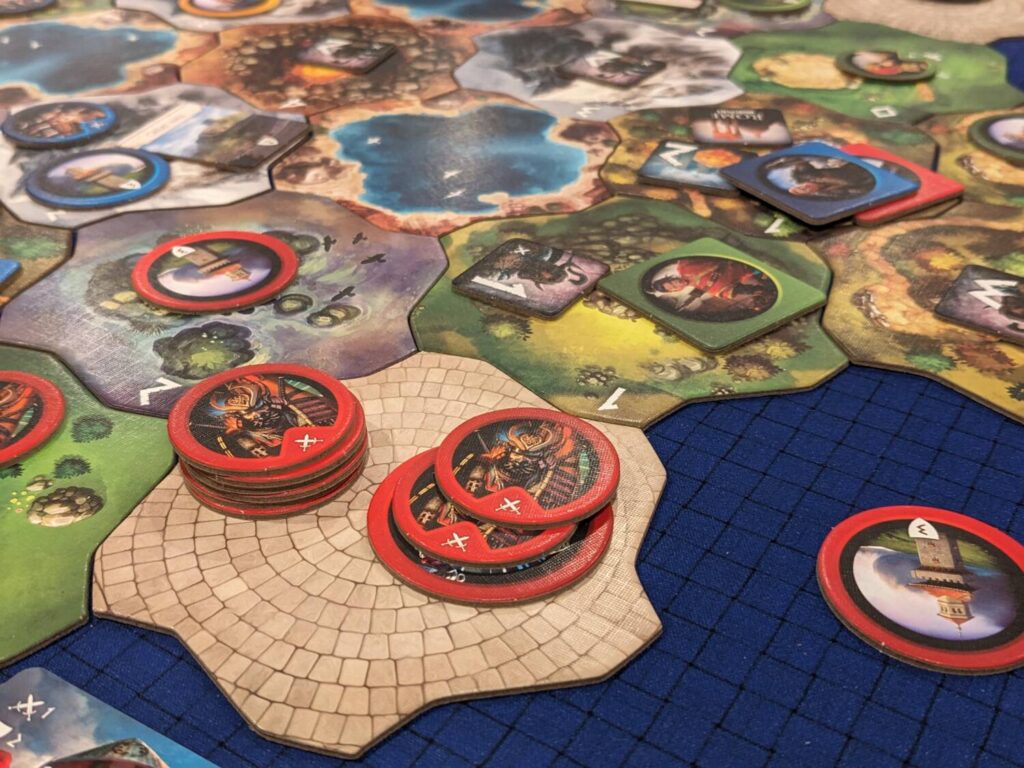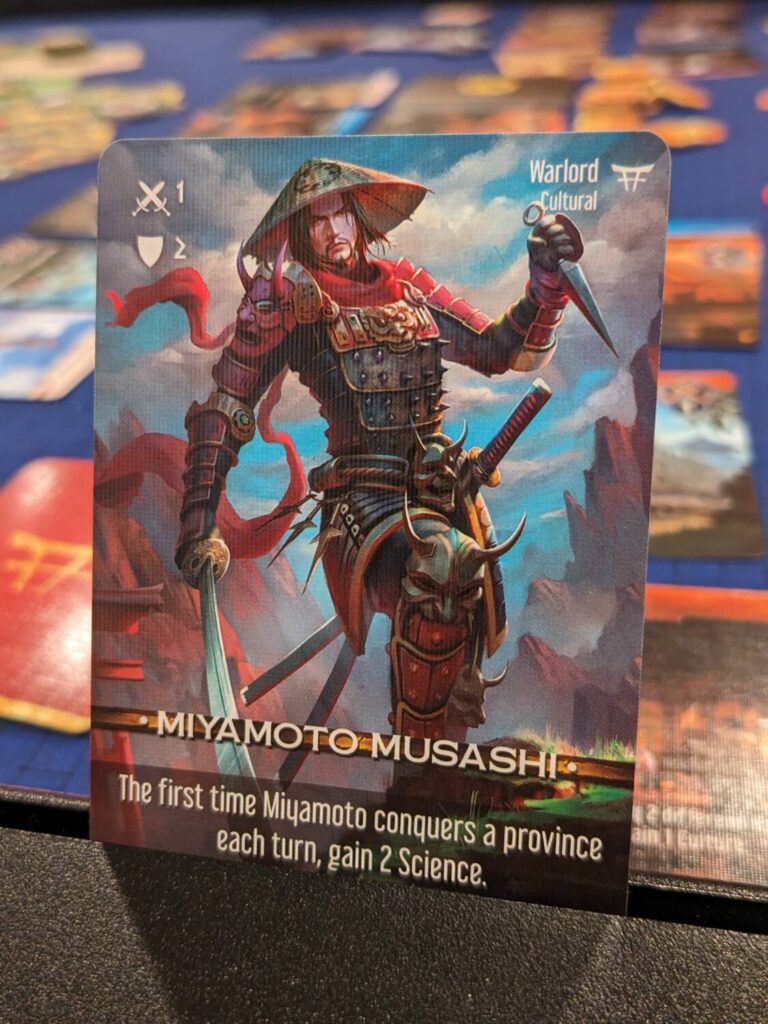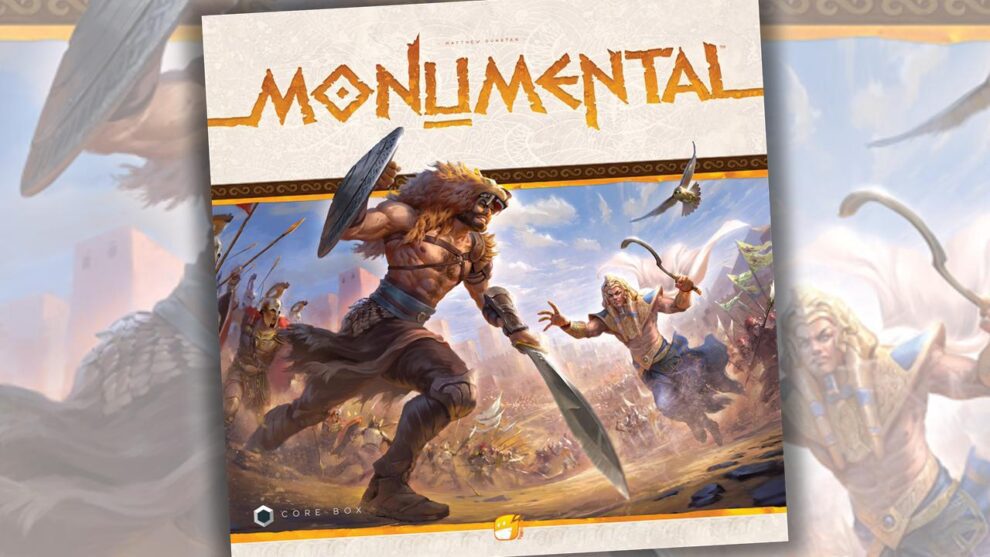Disclosure: Meeple Mountain received a free copy of this product in exchange for an honest, unbiased review. This review is not intended to be an endorsement.
Here are the scariest words in the English language: “During your turn, you may take any of the following actions, any number of times, in any order and combination you want, as long as you have the resources needed to carry them out.”
This line, on page five of the English rulebook for the 4X-ish deckbuilding skirmish game Monumental (2020, Funforge), frightened me when I read it. In the wrong hands, a player could take a lot of actions on their turn while taking time to consider what they wanted to do on a turn…all while three other players would be waiting for the active player to wrap things up.
And during our very first review play of Monumental—on the fourth turn of the first round!!—a player strung together a series of actions that took maybe six or seven minutes. Not long in the scheme of things, right?
Then the next two players also took turns that ran about five minutes each. That left me waiting for about 15 minutes to take my second turn of the game.
Monumental does quite a few things well. Unfortunately, the game is buried in downtime, which takes away from an experience that should shine at higher player counts but assures that I will never play it again with four players.

Could You Pass Me the Statue of Liberty Token?
Monumental is a 1-4 player deckbuilding game, placing players in the role of a civilization leader over the course of history (Egyptians, Danes, the Japanese, etc.). There are certainly other game elements to consider, thanks to end-game scoring requirements tied to area control, the acquisition of world wonders—powerful cards that are also used to boost defense of provinces—and “knowledge” cards, which can boost a player’s turn during the action phase and provide an opportunity for a set collection majority bonus.
But our group felt that Monumental is first and foremost a deckbuilding game. You begin the game with 15 somewhat poor cards, and a couple of special actions. The game clock is tied to the market of new cards, and there are three piles of “basic” building cards that you should definitely buy early on to help get rid of those starting cards at the first opportunity.
If you don’t prioritize gutting starting cards by taking the Archive action (Monumental’s version of the Trash, Banish, and/or Destroy action in other deckbuilders, which permanently removes cards from the game), you are in for a long night.
Monumental’s “wow” moments come during each player’s first step, the Activate City phase. Each player’s starting deck includes 15 cards, 13 of which appear in every deck and two unique cards. To begin a turn, the active player has a 3×3 grid of face-up cards from this deck that must be activated by tilting/tapping cards in one row and one column. Tilted cards are the ones players will use on their turn to produce resources and activate effects, while also choosing from the game’s nine (yep, nine) base actions.
Figuring out which rows and columns to activate was an interesting puzzle. It was also fun to figure out, based on anything that happened on the turns prior to my own, which resources I might need to buy a card from the market or actions to allow me to archive a card to get it out of my deck.
The Activate City step really shines in Monumental. Remember that line earlier that really scared me? I was right to be scared, because on every turn, a player would finish the Activate City step, have a bunch of resources to spend on a turn, then take a deep breath while trying to execute a series of actions.
Look, I like combos. Games like Tiletum and Inventions: Evolution of Ideas are chock-full of combos. But games like Monumental, share one consistent issue—no one wants to watch me take a five-minute turn where I knock out all my cool combos. This spikes when there’s nothing for other players to do in-between turns.

So, You Had Fun?
Monumental does so much so well that it is a shame the overall experience for our group was only fine in the end.
The game’s playtime, even if the individual turn downtime was better, is still a bit too long. When the draw deck runs out, the game begins to end. I say “begins” because you have to finish the round where the last card is dealt to the market, then play an additional complete round before the game ends.
Now, while it is tough to wait for the active player to finish their turn, being the active player is a blast. Some of the ways players activate their city and then get more resources during their turn are fantastic. Each player has a small set of “Cultural Policy” cards that help a player break the game’s core rules, and some of them are really spicy when it comes to taking conquest actions or getting extra resources when adding new Cultural Policy cards to their city.
Combat is quick. Monumental shrinks the combat step of conquering other territories to a simple formula. Match a territory’s terrain value and enemy defense value with any combination of your units, and you take control. That also means that the opposing player (if that territory was controlled by someone else) doesn’t even need to be at the table for the combat to resolve. It just…happens. Moving units is also straightforward—if the unit has a path to get to its final destination, it costs one military resource to move one unit anywhere on the map.
The area control elements aren’t exhilarating, but they do add a fun element to how players math out their chances of beating other players (and, like most area control games, going last is quite powerful in Monumental). The gold resource adds flexibility for anyone trying to take the right kinds of actions at the situationally best time. Some of the bonuses achieved when adding a Wonder are super sweet.
I received the basic version of the game for this review, and for a non-deluxified version, Monumental is a handsome production. The insert is solid, the cardboard tiles do the job (and actually fit on each of the map tiles, unlike the minis), and the card stock feels great in the hands. I like the variety of map setups included in the separate setup manual, and there’s an option to create your own maps too. There are even bonus modules in the base game for those looking for a game with some legs.
My main issue with the Monumental production is the player aid…because there isn’t one. A game with nine separate actions needs a player aid, full stop. The manual is laid out well and provides a few photo examples of situations that happened even during our first play. But the back of the manual could have easily been used as an action reminder list. A player aid would have been preferred.

Recommended, But Only at Lower Player Counts
Our first play of Monumental—with four players who watched Tim Chuon’s teach video prior to our play, eliminating the need for a teach—took two hours and 45 minutes. One guy was beginning to fall asleep at the table by the end of the game (although this guy also has a two-month-old, so sleep isn’t his friend right now). Two players asked multiple times about the game’s end trigger.
Those are signs of a group that are excited to see a game end, and when our game did end, the hot takes came out immediately.
“Longest deckbuilder ever,” said one.
“I loved the first hour, but it was tough to concentrate by the end,” said another.
Scoring the game was easy. The game includes a score tracker—completely unnecessary, but a nice production touch—to make scoring a cinch. Scores stay low thanks to the small list of scoring elements, many of which score one or two points for having certain cards or controlling tiles on the map, with bonuses for having the most of something.

Long term, Monumental faces two challenges in order to land with the kinds of gamers who populate my groups.
First, I would never play it with four players again. This feels like a two-player game, but these semi-head-to-head 4X-style games sometimes turn off players who were looking for a larger group to play against. Maybe three players is best?
Second, the Activate City mechanic is the reason to try this game. Beyond that, Monumental does a lot of 4X-ish things that many other games do better. I prefer the exploration and exploit actions in games like Scythe and Brazil: Imperial. The extermination (combat) in Voidfall is just flat-out better, particularly because both Voidfall and Monumental take the deterministic combat route. (The techs in Voidfall make the combat cycle more satisfying too.)
If anything, Monumental is unique because it tries to combine deckbuilding with some of these lighter 4X games. However, I found that I just wanted to play Clank!, Lost Ruins of Arnak, Dune: Imperium, or other deckbuilder combination games that have a great table presence with shorter playtimes. Monumental’s biggest asset might be its variability. There are a number of expansion modules that the publisher has built to serve an audience for months, if not years, of future plays.
As is, I think Monumental is a good game buried under player turns that run much too long. I know I can’t get the three review crew members who joined me for my first play to try again, which might be all you need to know about where we landed.












Add Comment